The most consistent
company releasing Italian product (genre or otherwise), NoShame Films has tackled
arthouse classics (BOCCACCIO 70, THE RAILROAD MAN), gialli (CASE OF THE SCORPION’S
TAIL, STRANGE VICE OF MRS. WARDH), Italian crime (ALMOST HUMAN, GAMBLING CITY)
and sexploitation (SENSUOUS NURSE, SECRETS OF A CALL GIRL). But A WHISPER IN
THE DARK is their first Italian ghost story release, and it’s an interesting
choice since many film fans have never seen, let alone heard of it. As long
as one doesn’t expect a clichéd ghost story, there are a number
of quiet chills to be had with this film. 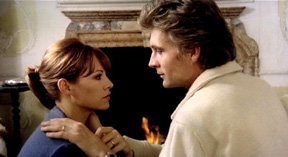
A family of Italian aristocrats is anything but normal: husband Alex Is having a series of affairs behind wife Camilla’s back, French governess Francoise tries to stop bratty twins Milena and Mathilde from making life miserable for their brother Martino, and their high society grandmother arrives to make Camilla feel more high-strung and anxious. But the most bizarre member of their family is Martino’s imaginary friend, Luca, who appears to be the ghost of Camilla’s miscarried son from a previous pregnancy and who may have supernatural abilities. A famous psychologist comes to stay with the family to discover why Martino is determined to keep the memory of the child alive…or if he indeed exists.
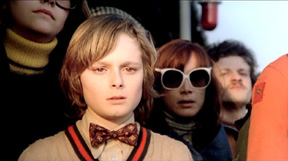 Ghost
stories shot in color are already starting with points taken off their success
rate; through no fault of the filmmakers, color just doesn’t work as well
for spooky supernatural stories. But WHISPER IN THE DARK starts off great, with
an interesting first 30 minutes introducing all the characters, their relationships
with one another, and the role the imaginary Luca plays in their lives. Sadly,
there is too much time spent on subplots (the extracurricular shenanigans of
Alex, the relationship between Francoise and Camilla, the father-son tour of
Venice), and this very lengthy film (100 minutes) could have lost at least 20
minutes without it affecting the primary storyline. The middle section of the
film is especially slow, with the psychologist character adding nothing to the
film as he arrives and dies. However, the highlights that remain include: a
quietly sinister scene with a floating red balloon, Luca playing goalie during
a game of soccer, a swing moving by itself, a mysterious thunderstorm destroying
the plans of the bickering twin sisters, a wicker man effigy burning on a lake,
a family kiss-and-guess game interrupted by Luca, Mathilde being dared by Luca
to walk along the edge of the villa’s balcony, and a fireside love scene
obviously inspired by DON’T LOOK NOW. The open-ended ending is terrible,
though. Not at all a horror film, WHISPER IN THE DARK works best as the story
of a family dealing with the spirit of one of their own. Many of the most effective
moments are touching in that they show Luca as not just an angry ghost, but
one looking for love from his mother and brother. If one goes into the film
knowing it isn’t a chilling shocker (as the DVD box suggests), it is an
interesting an
Ghost
stories shot in color are already starting with points taken off their success
rate; through no fault of the filmmakers, color just doesn’t work as well
for spooky supernatural stories. But WHISPER IN THE DARK starts off great, with
an interesting first 30 minutes introducing all the characters, their relationships
with one another, and the role the imaginary Luca plays in their lives. Sadly,
there is too much time spent on subplots (the extracurricular shenanigans of
Alex, the relationship between Francoise and Camilla, the father-son tour of
Venice), and this very lengthy film (100 minutes) could have lost at least 20
minutes without it affecting the primary storyline. The middle section of the
film is especially slow, with the psychologist character adding nothing to the
film as he arrives and dies. However, the highlights that remain include: a
quietly sinister scene with a floating red balloon, Luca playing goalie during
a game of soccer, a swing moving by itself, a mysterious thunderstorm destroying
the plans of the bickering twin sisters, a wicker man effigy burning on a lake,
a family kiss-and-guess game interrupted by Luca, Mathilde being dared by Luca
to walk along the edge of the villa’s balcony, and a fireside love scene
obviously inspired by DON’T LOOK NOW. The open-ended ending is terrible,
though. Not at all a horror film, WHISPER IN THE DARK works best as the story
of a family dealing with the spirit of one of their own. Many of the most effective
moments are touching in that they show Luca as not just an angry ghost, but
one looking for love from his mother and brother. If one goes into the film
knowing it isn’t a chilling shocker (as the DVD box suggests), it is an
interesting an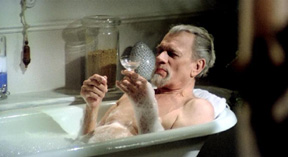 d
moving viewing experience.
d
moving viewing experience.
John Philip Law (DIABOLIK) and Nathalie Delon (BLUEBEARD, and the wife of Alain Delon) are rather uninteresting as the concerned parents, and Joseph Cotten appears in a mere extended cameo as the psychologist who ends up dead in the bathtub. Child actor Alessandro Poggi does a very good job as Martino, the misunderstood son, though, and Lucretia Love appears long enough to provide some comic relief and a full-frontal nude bathtub scene. The behind-the-scenes talent is much more impressive, and is the reason why the film works. Composer Pino Donaggio, whose works for Brian DePalma remain his finest, contributes a beautiful score with lush strings, piano and woodwinds, and cinematographer Claudio Cirillo does a marvelous job at capturing the massive family villa and it is to his credit that the few successful spook moments work. One scene of a swing almost smacking into the camera is quite memorable, as is the bizarre dream sequence in a snowy, foggy garden near the finale.
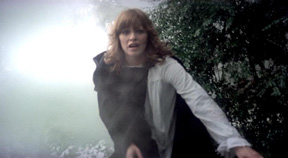 As
the box copy states, the film has been “painstakingly restored from the
original vault negatives” and that sums it up beautifully as it's presented
16x9 and 1.85:1 widescreen. The opening sequences of a fog-enshrouded garden
are bright and clear, then transition to the family breakfast scene filled with
glorious color, clean image quality, and dark blacks. Some discoloration appears
in a few scenes, usually marring the skin tones, and a strange instance of print
damage appears at about 1:16:00, but this is still a gorgeous transfer for such
a rare film. Two language options are included, the original Italian with English
subtitles or the English dub. As with many Italian films, the film seems to
have been shot in English (except for several sequences with the child actors,
who speak in Italian), so the English dub is preferable. But the Italian language
track is nice, too. The English track has some scratches at reel changes during
the last half of the film, but nothing distracting.
As
the box copy states, the film has been “painstakingly restored from the
original vault negatives” and that sums it up beautifully as it's presented
16x9 and 1.85:1 widescreen. The opening sequences of a fog-enshrouded garden
are bright and clear, then transition to the family breakfast scene filled with
glorious color, clean image quality, and dark blacks. Some discoloration appears
in a few scenes, usually marring the skin tones, and a strange instance of print
damage appears at about 1:16:00, but this is still a gorgeous transfer for such
a rare film. Two language options are included, the original Italian with English
subtitles or the English dub. As with many Italian films, the film seems to
have been shot in English (except for several sequences with the child actors,
who speak in Italian), so the English dub is preferable. But the Italian language
track is nice, too. The English track has some scratches at reel changes during
the last half of the film, but nothing distracting.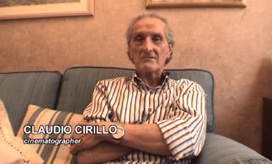
An introduction by cinematographer Claudio Cirillo appears before the film (and cannot be skipped past), and he also contributes a 30-minute (!) video interview. He discusses his beginnings as a cinematographer, wild adventures shooting for other directors, working with the undiscipled director Marcello Aliprandi on WHISPER IN THE DARK, the beautiful villa which is a hotel now, shooting in Venice, difficulties lighting the sets, his cameo as a detective, memories of Joseph Cotton and Pino Donaggio (he cameos in the film, too!), and his love for actors. The Italian trailer (with English subs), an Italian posters and stills gallery, and a booklet with liner notes and bios of Joseph Cotten and John Philip Law by Richard Harland Smith are also included. (Casey Scott)